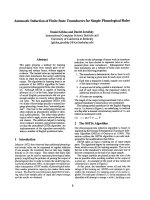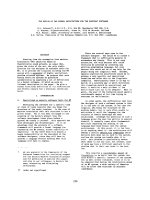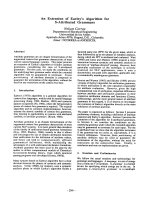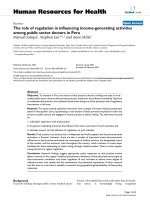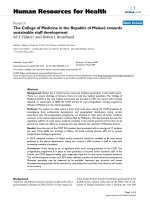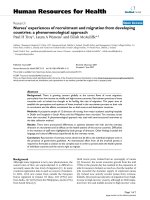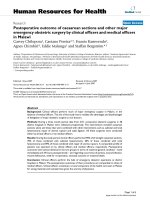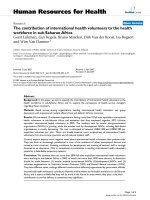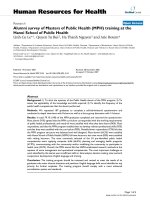báo cáo sinh học:" An experience of virtual leadership development for human resource managers" ppt
Bạn đang xem bản rút gọn của tài liệu. Xem và tải ngay bản đầy đủ của tài liệu tại đây (143.43 KB, 3 trang )
BioMed Central
Page 1 of 3
(page number not for citation purposes)
Human Resources for Health
Open Access
Commentary
An experience of virtual leadership development for human
resource managers
Karen E Sherk*, Fiona Nauseda, Sarah Johnson and Delphine Liston
Address: Management Sciences for Health, Cambridge, MA, USA
Email: Karen E Sherk* - ; Fiona Nauseda - ; Sarah Johnson - ;
Delphine Liston -
* Corresponding author
Abstract
Problem: Strong leadership and management skills are crucial to finding solutions to the human
resource crisis in health. Health professionals and human resource (HR) managers worldwide who
are in charge of addressing HR challenges in health systems often lack formal education in
leadership and management.
Approach: Management Sciences for Health (MSH) developed the Virtual Leadership
Development Program (VLDP) with support from the United States Agency for International
Development (USAID). The VLDP is a Web-based leadership development programme that
combines face-to-face and distance-learning methodologies to strengthen the capacity of teams to
identify and address health challenges and produce results.
Relevant changes: The USAID-funded Leadership, Management and Sustainability (LMS)
Program, implemented by MSH, and the USAID-funded Capacity Project, implemented by
IntraHealth, adapted the VLDP for HR managers to help them identify and address HR challenges
that ministries of health, other public-sector organizations and nongovernmental organizations are
facing.
Local settings: Three examples illustrate the results of the VLDP for teams of HR managers:
1. the Uganda Protestant and Catholic Medical Bureaus
2. the Christian Health Association of Malawi
3. the Developing Human Resources for Health Project in Uganda.
Lessons learnt: The VLDP is an effective programme for developing the management and
leadership capacity of HR managers in health.
Introduction
The articles in this series on leadership and human
resources (HR) have demonstrated the critical role that
effective leadership plays in transforming HR strategies
into results on the ground. It is essential that groups like
the Global Health Workforce Alliance and the World
Health Organization (WHO), as well as agencies such as
the United States Agency for International Development
(USAID) and other donors continue to provide leadership
on a global level.
Published: 8 January 2009
Human Resources for Health 2009, 7:1 doi:10.1186/1478-4491-7-1
Received: 30 April 2008
Accepted: 8 January 2009
This article is available from: />© 2009 Sherk et al; licensee BioMed Central Ltd.
This is an Open Access article distributed under the terms of the Creative Commons Attribution License ( />),
which permits unrestricted use, distribution, and reproduction in any medium, provided the original work is properly cited.
Human Resources for Health 2009, 7:1 />Page 2 of 3
(page number not for citation purposes)
Discussion
Building HR leadership and management at all levels of
the health system
How can we rapidly build HR leadership and manage-
ment capacity at all levels of the health system? One
approach to meet this challenge that has demonstrated
promising results is the Virtual Leadership Development
Program (VLDP). Developed by Management Sciences for
Health (MSH) with support from USAID, the programme
has been delivered to more than 1900 participants in
more than 45 countries in Africa, Asia, the Eastern Medi-
terranean and Latin America and the Caribbean as of
December 2008. Its premise is simple: bring teams of
managers together and give them the skills and tools to
scan their environments, focus on priority challenges,
align and mobilize resources, address challenges and pro-
duce results.
Around the world, health professionals and HR managers
are leading and managing public and private health
organizations and systems with little or no formal man-
agement and leadership education and experience.
Because strong management and leadership skills are cru-
cial to finding solutions to the HR crisis, this is a gap that
must be addressed.
Traditional ways to build capacity to lead change, such as
sending an individual to an off-site workshop or course,
can be slow and costly, and may disrupt services. Other
disadvantages of traditional approaches include a theoret-
ical rather than practical focus and participation of too
few staff from the same organization in such training.
Finally, when people are trained individually, they may
find it difficult to generate support for change when they
return to their workplaces.
The Virtual Leadership Development Program
The VLDP is a Web-based programme that strengthens the
capacity of teams to identify and address health chal-
lenges and produce results. It is available in Arabic, Eng-
lish, French, Portuguese, Russian and Spanish. Rather
than giving a few senior managers off-site leadership
training for one or two weeks, the VLDP trains teams via
the Internet over the course of 13 to 16 weeks.
Adapted for HR managers and their teams and health serv-
ices teams working on HR issues, the VLDP for HR man-
agers focuses on identifying and addressing HR
challenges. During the programme, each team strengthens
its leadership capacity by applying MSH's leadership prin-
ciples and practices and a model of challenge, feedback
and support.
The VLDP requires approximately four hours of individ-
ual commitment per week. Team members work inde-
pendently on the VLDP Web site with the support of a
printed workbook. They also participate in on-site team
meetings throughout the programme. During the VLDP,
all the teams plan and develop a leadership project that
addresses a real organizational challenge.
In 2006 and 2007, the Capacity Project, funded by USAID
and implemented by IntraHealth, joined the USAID-
funded Leadership, Management, Sustainability (LMS)
Program implemented by MSH to deliver two VLDPs to
teams of HR managers from different levels in ministries
of health, private hospitals, universities, NGOs, and faith-
based organizations in Ethiopia, Ghana, Kenya, Lesotho,
Madagascar, Namibia, Nigeria, Rwanda, South Africa,
Tanzania, and Uganda. The two programmes were jointly
facilitated by a team of facilitators from MSH, IntraHealth
and the Eastern and Southern Africa Management Insti-
tute (ESAMI). The challenges identified by the teams dur-
ing the VLDPs spanned the gamut of HR issues, from staff
retention to the need for good HR information.
The impact of the VLDP on HR managers
Follow-up with the teams that participated in the VLDPs
for HR managers took place in April and November 2007.
Interviews with representatives from the teams revealed
that teams are:
• beginning to demonstrate results as they implement
their VLDP action plans to address the HR management
challenges they identified;
• applying the concepts they learnt in the programme and
using leadership and management tools in their organiza-
tions;
• working better in their organizational teams.
Examples of teams' progress as of November 2007 appear
below.
The Uganda Protestant and Catholic Medical Bureaus
(UPMB and UCMB)
The UPMB and UCMB are umbrella organizations that
oversee faith-based, private, not-for-profit health facilities
in Uganda. During the first HR managers' VLDP, the team
in Uganda identified actions to address their challenge of
"retaining qualified health workers in the private not-for-
profit health facilities." The activities included holding a
consultation workshop with the health facility managers
and designing and implementing a study to collect data
about staff attrition. The study data will be used to
develop retention strategies. The respondent reported that
the team held the workshop, developed a survey and is
collecting data. In July 2007, the team reported that they
had implemented several staff-retention strategies. They
Publish with BioMed Central and every
scientist can read your work free of charge
"BioMed Central will be the most significant development for
disseminating the results of biomedical research in our lifetime."
Sir Paul Nurse, Cancer Research UK
Your research papers will be:
available free of charge to the entire biomedical community
peer reviewed and published immediately upon acceptance
cited in PubMed and archived on PubMed Central
yours — you keep the copyright
Submit your manuscript here:
/>BioMedcentral
Human Resources for Health 2009, 7:1 />Page 3 of 3
(page number not for citation purposes)
have harmonized data collection instruments between the
Protestant and Catholic Medical Bureaus in order to regu-
larly monitor information such as personnel data, using
these data to observe trends and take steps to reduce attri-
tion. They have also coordinated with the Ministry of
Health (MOH) on the hiring and placing of MOH staff
with their organization, which has helped with retention
and consistency. They have identified and learnt to better
advertise the benefits of working for their organization.
They say these changes were possible because of the lead-
ership skills they gained through the VLDP.
The Christian Health Association of Malawi (CHAM)
CHAM is a nonprofit, nongovernmental umbrella organ-
ization that oversees 167 member health units in all dis-
tricts of Malawi. While participating in the second HR
managers' VLDP, CHAM identified the following chal-
lenge: "How can we attract and retain qualified health per-
sonnel in three remote health facilities?"
The team outlined activities to address this challenge,
including the installation of solar electricity in the facili-
ties, service-level agreements for site renovations and
development of staff incentive packages. In November
2007, a respondent from CHAM reported that the team
has installed two Japan International Cooperation Agency
(JICA)-donated solar energy systems in two of the three
remote sites. Because of discussions held during the VLDP
they were able to identify the need for the solar energy sys-
tems in remote sites as opposed to the planned installa-
tion closer to cities. Other progress includes the
construction of two new homes near the remote sites; the
establishment of three renovation service agreements; and
collection of regional data by the team for the develop-
ment of incentive packages.
Developing Human Resources for Health (DHRH) in
Uganda
DHRH is a European Union-supported, five-year project
focusing on strengthening HR for health in Uganda. In
November 2007, a respondent from the DHRH team in
Uganda reported that the team has made important
progress in addressing its challenge of improving the
learning environment and opportunities for developing
clinical laboratory skills among clinicians and medical
and nursing students. The actions identified included
establishing four skills laboratories in a national referral
hospital and a school of nursing and identifying and
training professional mentors. The respondent reported
that skills laboratories have been established in 12
schools and medical institutions, and the team completed
the training of 15 mentors and developed a training guide
for training future mentors
Conclusion
The VLDP is a model for strengthening the leadership
capacity of all staff who have some responsibility for
human resource issues in the health sector. It provides a
way to upgrade the HR skills of the legions of personnel
administrators and managers responsible for human
resources and give them the confidence and capacity to
implement solutions.
Competing interests
The authors declare that they have no competing interests.
Authors' contributions
SJ and KES oversee the implementation of all VLDPs for
MSH. FN and DL managed the implementation of the two
VLDPs discussed in this article. FN and DL also managed
and completed the follow-up with VLDP teams discussed
in this article. KES drafted the manuscript and SJ reviewed
and edited it. All authors read and approved the final
manuscript.
